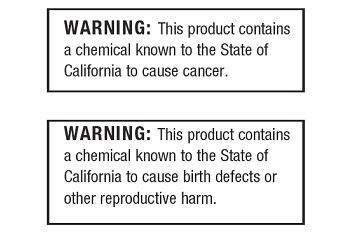On August 30, 2018, California’s complex new Proposition 65 requirements for “clear and reasonable warnings” will take full effect, impacting companies across the country that do business in the Golden State. Though the Office of Environmental Health Hazard Assessment (OEHHA) adopted the new regulations in August 2016, businesses have had a 2-year phase-in period to adopt the new warning system. If your organization is still using the old warnings, here is what you need to know to become compliant before the August deadline.
What Is Prop 65?
Proposition 65, officially known as the Safe Drinking Water and Toxic Enforcement Act of 1986, requires businesses with 10 or more employees to provide “clear and reasonable” warnings when they knowingly and intentionally expose anyone to state-listed chemicals that can cause cancer or reproductive harm. This requirement applies to every manufacturer, producer, packager, importer, supplier, and distributor that operates in California or sells products in California.
Since the original warning regulations took effect in 1988, companies were simply required to state that a chemical was present in a product or area that could cause cancer or reproductive harm, but they were not required to provide further information. Now the rules have become exceedingly more complex.
What’s Changing?
Under the extensive new requirements, warnings for consumer products must state that the product “can expose you to” a listed chemical rather than simply stating that the product “contains” the chemical. The warnings must also include the name of at least one listed chemical that triggered the warning, the word “WARNING” in all capital letters and bold print, a warning symbol consisting of a black exclamation point in a yellow or black and white triangle, and the Internet address for OEHHA’s Proposition warnings website (www.P65Warnings.ca.gov).
The new “clear and reasonable” warning system also:
- Adds new tailored warnings that provide specific information for certain kinds of exposures, products, and places, such as for alcoholic and nonalcoholic beverages, food, prescription drugs, dental care, vehicles, enclosed parking garages, amusement parks, service stations, and designated smoking areas;
- Requires website warnings for products purchased on the Internet;
- Requires catalog warnings for products sold by direct marketers;
- Requires warnings to be provided in other languages in addition to English in certain circumstances; and
- Clarifies the roles and responsibilities of manufacturers and retailers in providing warnings. Specifically, the new system places the primary responsibility for providing the warnings on manufacturers, that can choose to put warning labels on the products directly or to provide notices to distributors, importers, or retailers.
Stay Vigilant
In addition to wanting to avoid agency enforcement where penalties can cost thousands of dollars per violation per day, companies doing business in California should be vigilant in their compliance with the new Proposition 65 requirements in order to avoid the expense and hassle of citizen lawsuits from so-called “bounty hunters.”
Proposition 65 contains a unique private enforcement provision that allows and encourages individual citizens to file lawsuits against businesses that fail to comply with its requirements. Citizens who successfully bring an action against a company can keep 25 percent of any penalty recovered, earning their “bounty hunter” nickname. These lawsuits are often the most expensive result of violations of Proposition 65, and you can be sure that bounty hunters will be on the lookout for companies that are too slow to adapt to the new clear and reasonable warnings regulations by August 30.
How to Prepare
Though most businesses should have begun their labeling changes and evaluating their warning systems by now, you should continue to monitor OEHHA’s website for ongoing regulatory adjustments and interpretive guidance as the compliance deadline approaches. Also, take a look at this recent EHS Daily Advisor article for more details.
Additionally, retailers and other distributors should contact their suppliers to make sure they will be fully prepared for the new requirements, and, if necessary, prepare new website and catalog warnings. Finally, though the existing warning system will suffice for products manufactured before August 30, companies should evaluate their existing inventory to make sure they can prove when these products were manufactured or be prepared to update their warning labels.

|
Watch BLR’s webinar, Labeling Hazardous Chemicals: The Impact CA’s Proposition 65 Requirements Will Have on Your Compliance Obligations, on-demand.
You’ll learn how to:
|


